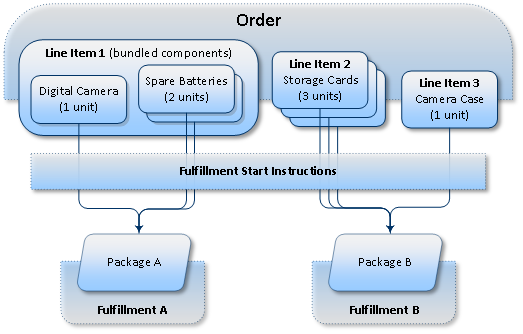The outcome of a buyer's eBay checkout process is an order. The set of specifications for addressing, handling, and shipping each package is known as a shipping fulfillment.
Note: Order payments are often processed immediately. Purchases that do not require upfront payment (e.g., COD) can be fulfilled even though they are not paid yet. Concurrently with the payment process, you need to manage and monitor the process of packaging, addressing, handling, and shipping each order. However, pending payment purchases that require upfront payment before shipment cannot be fulfilled until the order is marked as paid.
Sellers manage the disposition of an order in accordance with the payment method and timing specified at checkout. The line items in the order are grouped into one or more packages.
Fulfillment objects
- Order – The order object contains information about an order that requires shipping.
- Line Item – The lineItem object contains details about one or more units of a sold item in an order.
- Shipping Fulfillment – The shippingFulfillment object contains information about one package and its delivery.
- Fulfillment Start Instruction – The fulfillmentStartInstruction object contains recommendations for fulfilling an order.
Object relationships
Following is an example of an order for digital photography equipment, illustrating the role that each Fulfillment object plays in the fulfillment workflow:

Relationship between an order and its fulfillments
In the example above, the order consists of three line items of various components in various quantities. This example illustrates how a single package can contain one or more line items.
Line item 1 contains bundled items, which currently must be packaged together. The fulfillment start instructions (derived from the buyer's and seller's eBay account preferences, the listing parameters, and the buyer's checkout selections), provide information that the seller can use in the process of defining shipping fulfillments for the order.
The seller has decided to assign line item 1 to its own package, A. Line items 2 and 3 have been combined in package B. Each package is handled by a corresponding fulfillment that the seller defines. This particular assignment of line items to packages might be necessary for any number of reasons, such as:
- The order is too heavy to ship in a single package.
- The line items are of varying sizes and shapes unsuitable for a single package.
- Some of the line items require a different shipping carrier or service.
To start processing orders for a seller, see Discovering unfulfilled orders.